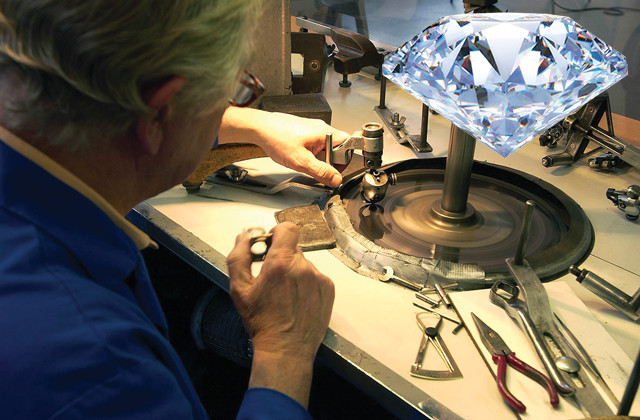
by USGS Mineral Commodities Team Thursday, June 14, 2018
Donald W. Olson, mineral commodity specialist for the U.S. Geological Survey, has compiled the following information on diamond, the world’s most popular gemstone, as well as one of the most useful industrial materials.

Ninety-two percent of the world's diamonds are cut and polished in India. Credit: Diamond: ©iStockphoto.com/Clint Spencer; Bottom: Andere Andre
Diamond is an extremely stable form of carbon: It is a material with superior physical properties due to the very strong covalent bonding between the carbon atoms. Diamond has the highest hardness and thermal conductivity of any known natural or synthesized material. In diamond, the carbon atoms are arranged in a rigid cubic crystal structure called a diamond lattice — it is this lattice that blocks impurities, thus giving diamond its colorless appearance.
Sometimes enough impurities can settle in the crystal lattice to cause the diamond to have color. The blue in a blue diamond, like the Hope Diamond, is caused by boron; the yellow in yellow canary diamonds is caused by nitrogen. In other cases, defects in the crystal lattice can make diamonds appear red, pink, orange or brown. Exposure to Earth’s natural radiation can create green diamonds. And “black” diamonds are not really black, but rather they contain numerous dark inclusions that give them their black appearance.
People have used diamonds as decorative items since ancient times. Some of the earliest historical references can be traced to India 2,500 years ago. Diamond rings have been used to symbolize engagements since at least the 15th century in Europe, but they became most popular in the early to mid-1900s as a result of promotional advertising by the De Beers Company.
Diamonds that do not meet gem-quality standards for clarity, color, shape or size are used as industrial-grade diamond. Because it is the hardest substance known, diamond has been used for centuries as an abrasive in cutting, drilling, grinding and polishing. Industrial-grade diamond continues to be used as an abrasive for many applications. Diamond also has chemical, electrical, optical and thermal characteristics that make it the best material available for wear- and corrosion-resistant coatings, heat sinks in electrical circuits, computing and other advanced technologies.
Natural diamonds were formed under high-pressure, high-temperature conditions in Earth’s mantle. The diamonds were brought close to Earth’s surface by deep volcanic eruptions of magma that cooled into igneous rocks called kimberlites and lamproites.
Diamonds are produced synthetically either by using a high-pressure, high-temperature process that simulates the conditions in Earth’s mantle, or by using a growth technique called chemical vapor deposition (CVD), which transforms carbon into plasma that is then precipitated onto a substrate as diamond. CVD has been used for more than a decade to cover large surfaces with microscopic diamond crystals that are very hard and wear resistant. More recently, this process has been used to grow single diamond crystals. CVD diamond precipitates as nearly 100 percent pure and almost flawless. Some manufacturers have recently begun selling synthetic gemstone diamonds.
Visit minerals.usgs.gov/minerals for more information on diamond.
Total worldwide natural diamond production was about 159 million carats in 2008: 87 million carats of gem-quality diamond and 72 million carats of industrial diamond.
The only U.S. diamond mine in operation is a dig-for-fee operation primarily for hobbyists located at the Crater of Diamonds State Park in Murfreesboro, Ark.
Russia is the world’s leading producer of natural diamond, followed by Botswana, Congo (Kinshasa), Australia, Canada and South Africa. These six countries produce more than 88 percent of the world’s natural diamond.
In 2008, the United States was the world’s leading market for gem-quality diamond, with a value that exceeded $19 billion.
The manufacture of every automobile made in the United States consumes 1.5 carats of industrial diamond.
Mary of Burgundy was the first known person to receive a diamond engagement ring in 1477 (from Hapsburg Emperor Maximilian I).
The leading uses of saw blades impregnated with industrial diamonds in the United States are for cutting dimension stone and for cutting and grooving concrete in highway reconditioning.
About 85 percent of the world’s rough diamonds, 50 percent of the world’s cut diamonds and 40 percent of the world’s industrial diamonds are traded in Antwerp, Belgium. Ninety-two percent of the world’s diamonds are cut and polished in India.
© 2008-2021. All rights reserved. Any copying, redistribution or retransmission of any of the contents of this service without the expressed written permission of the American Geosciences Institute is expressly prohibited. Click here for all copyright requests.